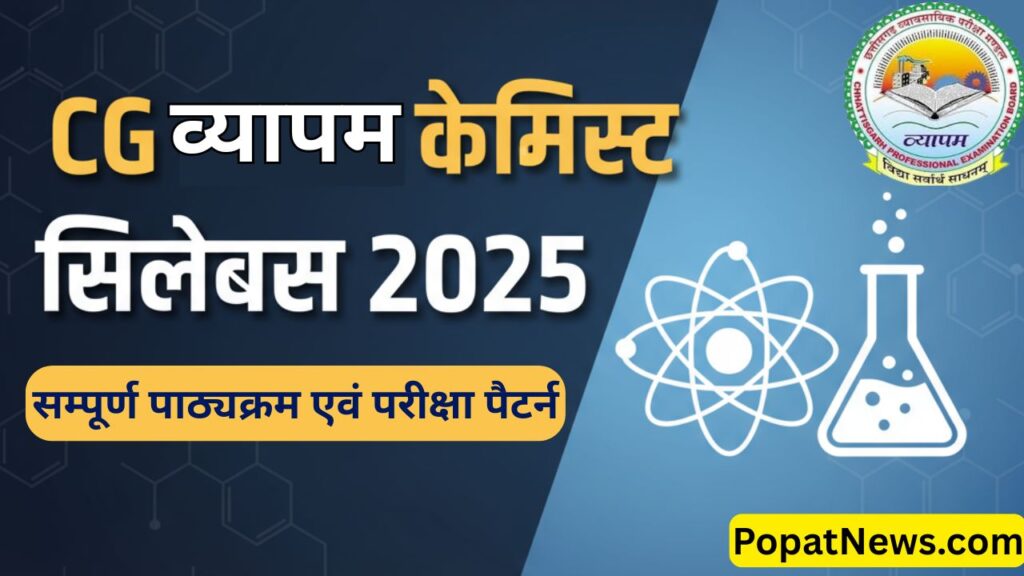CG Vyapam Chemist Syllabus 2025: लोक स्वास्थ्य यांत्रिकी विभाग रसायनज्ञ भर्ती का नया सिलेबस और एग्जाम पैटर्न यहाँ देखें। सामान्य अध्ययन और रसायन विज्ञान के 100 अंकों के सम्पूर्ण पाठ्यक्रम की जानकारी पाएं और अपनी तैयारी को सही दिशा दें।
CG Vyapam Chemist Recruitment 2025 Syllabus: क्या आप छत्तीसगढ़ व्यावसायिक परीक्षा मंडल (CG Vyapam) द्वारा लोक स्वास्थ्य यांत्रिकी विभाग में केमिस्ट (रसायनज्ञ) पद के लिए तैयारी कर रहे हैं? किसी भी परीक्षा में सफलता प्राप्त करने के लिए उसके पाठ्यक्रम और परीक्षा पैटर्न की विस्तृत जानकारी होना अत्यंत आवश्यक है। CG Chemist Vacancy 2025 Syllabus
CG Vyapam Chemist Syllabus and Exam Pattern: आपकी तैयारी को आसान और दिशाबद्ध बनाने के लिए, हम यहाँ केमिस्ट भर्ती परीक्षा का संपूर्ण सिलेबस प्रस्तुत कर रहे हैं। यह परीक्षा कुल 100 अंकों की होगी, जिसमें 100 वस्तुनिष्ठ प्रश्न होंगे। CG PHE Chemist Syllabus 2025
परीक्षा पैटर्न का संक्षिप्त विवरण | CG Vyapam केमिस्ट सिलेबस 2025
| भाग | विषय | प्रश्नों की संख्या | कुल अंक |
| भाग- I | सामान्य अध्ययन | 25 | 25 |
| भाग- II | रसायन विज्ञान | 75 | 75 |
| कुल | 100 | 100 |
CG Vyapam Chemist Syllabus PDF Download – यहाँ से डाउनलोड करें
CG Vyapam Chemist Recruitment 2025 – जानकारी के लिए यहाँ क्लिक करें
विस्तृत पाठ्यक्रम (Detailed Syllabus)
भाग-I: सामान्य अध्ययन (अंक- 25)
इस भाग में कुल 25 प्रश्न होंगे, जिनमें से प्रत्येक प्रश्न 1 अंक का होगा।
अ. सामान्य ज्ञान (अंक- 10)
- हाई स्कूल स्तर तक का सामान्य विज्ञान।
- हाई स्कूल स्तर तक का भारत का भूगोल।
- हाई स्कूल स्तर तक का सामान्य गणित।
- सम-सामयिक राष्ट्रीय महत्व के घटनाक्रम।
- खेल-राष्ट्रीय स्तर के खेल पर सामान्य प्रश्न।
- सामान्य बौद्धिक योग्यता- हाई स्कूल स्तर तक का विश्लेषण एवं तार्किक योग्यता।
ब. छत्तीसगढ़ का सामान्य ज्ञान (अंक- 15)
- छत्तीसगढ़ का इतिहास, स्वतंत्रता आंदोलन में छत्तीसगढ़ का योगदान।
- छत्तीसगढ़ का भूगोल, जलवायु, जनगणना, पुरातात्विक, दार्शनिक एवं पर्यटन स्थल।
- छत्तीसगढ़ का साहित्य, कला एवं संस्कृति, मुहावरें, हाना, एवं लोकोक्तियाँ।
- छत्तीसगढ़ की जनजातियाँ, बोली/भाषा, विशेष परम्पराएँ, तीज, व्यंजन/पकवान, पर्व एवं त्यौहार।
- छत्तीसगढ़ की अर्थव्यवस्था, वन, कृषि एवं वर्षा।
- छत्तीसगढ़ का प्रशासनिक ढाँचा, स्थानीय शासन एवं पंचायती राज तथा स्थानीय खेलकूद।
- छत्तीसगढ़ में उद्योग, ऊर्जा, जल एवं खनिज संसाधन।
- छत्तीसगढ़ की सम-सामयिक घटनाएँ।
भाग-II: रसायन विज्ञान (अंक- 75)
इस भाग में रसायन विज्ञान से कुल 75 प्रश्न होंगे, प्रत्येक प्रश्न 1 अंक का होगा।
1. Inorganic Chemistry (अकार्बनिक रसायन)
- Atomic number, Electronic configuration of elements, Aufbau principle, Hunds Multiplicity Rule, Pauli’s Exclusion principle, Long form of periodic table, classification of elements, Atomic and ionic radii, ionization potential, electron affinity and electronegativity.
- Natural and artificial radioactivity, Nuclear fission and fusion.
- Electronic theory of valency, Elementary ideas about sigma and pi bonds, hybridization and directional nature of covalent bonds, Oxidation states and oxidation number, Common oxidising and reducing agents, Ionic equations, Bronsted and Lewis theories of acids and bases.
- Chemistry of the common elements and their compounds treated especially from the point of view of periodic classification, principles of extraction, isolation of common elements.
- Werner’s theory of coordination compounds, Electronic configurations of complexes involved in the common metallurgical and analytical operation.
- Structures of hydrogen peroxide, persulfuric acids, diborane, aluminium chloride and the important oxyacids of nitrogen, phosphorus, chlorine and sulphur.
- Inert gases; Isolation and chemistry, Principles of inorganic chemical analysis, sulphuric acid, cement, glass and artificial fertilizers.
2. Organic Chemistry (कार्बनिक रसायन)
- Modern concepts of covalent bonding. Electron displacements, inductive, mesomeric and hyperconjugative effects. Effect of structure on dissociation constants of acids and bases, Resonance and its applications to organic chemistry, principles of organic reaction mechanisms, addition, nucleophilic and electrophilic substitution.
- Alkanes, alkenes and alkynes, petroleum as a source of organic compounds.
- Simple derivatives of aliphatic compounds; Alcohols, Aldehydes, Ketones, acids, halides, esters, ethers, amines, acid, anhydride, chlorides and amides, monobasic hydroxy and amino acids.
- Malonic and acetoacetic esters, unsaturated and dibasic acids. Lactic, tartaric, citric, maleic and fumaric acids.
- Carbohydrates; classification and general reactions, Glucose, fructose and sucrose. Organometallic compounds, Grignard reagents.
- Stereo-chemistry; optical and geometrical isomerism. Concept of conformation.
- Benzene and its simple derivatives; Toluene, Xylenes, phenols, halides, nitro and amino compounds. Benzoic, salicylic, cinnamic, mandelic and sulphonic acids.
- Aromatic aldehydes and ketones, Diazo, azo, hydrazo compounds: Aromatic substitution.
- Naphthalene, pyridine and quinoline; synthesis, structure and simple reactions.
- Simple chemistry of economically important materials e.g. coal tar, starch, oils, fats and protein.
3. Physical Chemistry (भौतिक रसायन)
- Gases: Kinetic theory of gases and gas laws, Maxwell’s law of distribution of velocities, van der waal’s equation, law of corresponding states. Liquefaction of gases, specific heats of gases, Ratio of cp/cv.
- Thermodynamics: The first law of thermodynamics; Isothermal and adiabatic expansions, Enthalpy, Heat capacities, Thermochemistry, Heats of reaction, formation, solution and combustion, calculation of bond energies, Kirchoff’s equation, Criteria for spontaneous change, Second law of thermodynamics, Entropy, Free energy, Criteria of chemical Equilibrium.
- Solutions: Osmotic pressure, lowering of vapour pressures, depression of freezing point, elevation of boiling point, Determination of molecular weight in solution, Association and dissociation of solutes.
- Chemical Equilibria & Kinetics: Law of mass action and its application to homogeneous and heterogeneous equilibria, le chatelier principle. Molecularity and order of a reaction, First order and second order reactions, Determination of order of a reaction, temperature coefficient and energy of activation.
- Electrochemistry: Faraday’s laws of electrolysis, conductivity of an electrolyte, equivalent conductivity and its variation with dilution; solubility of sparingly soluble salts, electrolytic dissociation, Ostwald’s dilution law; anomaly of strong electrolytes; solubility product, strength of acids and bases; hydrolysis of salts; hydrogen ion concentration, buffer action, theory of indicators. Reversible cells, standard hydrogen and calomel electrodes, Electrodes and redox-potentials, concentration cells, Determination of pH, Transport number, ionic product of water, potentiometric titrations.
- Phase Rule: Explanation of the terms involved. Application to one and two components system, Distribution law.
- Colloids: General nature of colloidal solutions and their classification, general methods of preparation and properties of colloids, coagulation, protective action and gold number, Absorption.
- Catalysis: Homogeneous and heterogeneous catalysis, promotors, poisoning.
- Photochemistry: Laws of photochemistry, simple numerical problems, and conceptual problems based on the full syllabus.

